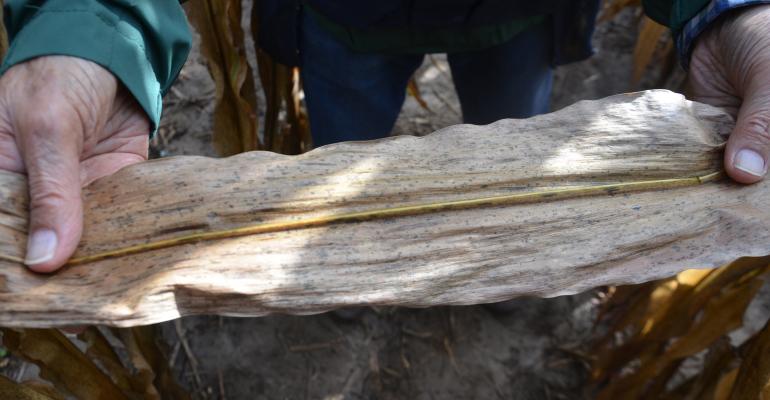Prepare for tar spot in ’22

Corn Pest Beat: Use all available tools and be ready to scout and monitor disease.
Mar 11, 2022
We saw tar spot in ’21. Ours wasn’t severe. Some say it paid to apply a fungicide at V10 and R2. Is that cost-effective every year? How do I know if this is the year?
The Indiana certified crop adviser panel answering this question includes Gene Flaningam, Flaningam Ag Consulting LLC, Vincennes; Brian Mitchem, area manager for
Nutrien Ag Solutions/Loveland Products, Decatur; Jeff Nagel, agronomist for Ceres Solutions, Lafayette; and Dan Quinn, Purdue Extension corn specialist.
Flaningam: My observations in southwest Indiana for tar spot in 2021 varied by hybrid, irrigation and planting date. I see a huge difference in hybrid resistance.
Review tar spot ratings with your seed dealer before applying excessive fungicide. Tar spot is enhanced by leaf wetness and travels from field to field by air currents.
Mitchem: Just because we had infection in 2021 doesn’t mean it will be impactful in 2022. Tar spot needs a favorable environment to flourish. Field scouting will determine timing of applications. Delaying application until close to reproduction remains the best option. If you want to experiment with a two-application program, target pre-tassel and make a second pass about 14 days later.
Nagel: Tar spot is a game-changer. The fungus overwinters on plant residue as those black spots called stromata. In season, stromata emit spores that land on green tissue. Severity is driven by moisture and humidity. Severity increases with more frequent rainfall and irrigation or high humidity.
Moisture was more frequent throughout the summer in some areas, causing an earlier start for tar spot. In those areas, a two-pass fungicide program applied in late vegetative and reproductive stages more adequately protected yields and provided a positive return on investment.
Whether you need one or two treatments will be driven by hybrid susceptibly and moisture. Don’t spray too early or too late. Consider these scenarios:
Best spray window. If you’re only spraying once, the best window is VT/R1 to R2. This was true even in 2021.
Two-pass option. If you have a history of severe tar spot and plan a two-pass program, make the first application 10 to 14 days before tasseling and the second about 30 days later.
Monitor and decide. Get the Tarspotter app. It helps predict when conditions are favorable for infection. Check more susceptible hybrids first. If you see tar spot and/or conditions are favorable, apply within seven to 14 days. If you don’t need to apply in the vegetative stages, make your VT/R1 to R2 application. Scout and use Tarspotter to decide if a second application is needed 21 to 30 days later.
Quinn: If tar spot isn’t severe, it would not be cost-effective to apply multiple fungicide applications. It’s not always cost-effective to apply fungicide every year, especially if disease isn’t present. Only in 2021 did Purdue research show a benefit to two applications, and only under severe tar spot conditions.
A single application at VT-R2 consistently provides strong disease protection. If tar spot is identified, track and monitor it. The tracking map and Tarspotter app can help you understand where and when the disease is currently active in Indiana, and if weather conditions are favorable.
Fungicide applications made every year regardless of disease presence and severity can limit overall profitability and increase potential for fungicide resistance.

